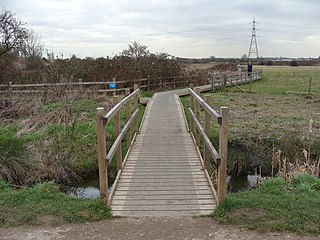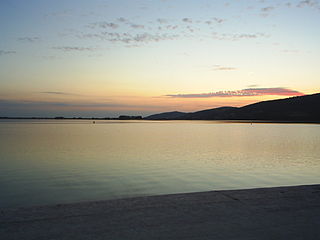
The Brent Reservoir is a reservoir in North West London. It straddles the boundary between the boroughs of Brent and Barnet and is owned by the Canal & River Trust. The reservoir takes its informal name from a public house called The Welsh Harp, which stood nearby until the early 1970s. It is a 68.6-hectare (170-acre) biological Site of Special Scientific Interest (SSSI), the only SSSI in either borough and among more than 30 SSSIs in Greater London.

Walthamstow Marshes, is a 36.7-hectare (91-acre) biological Site of Special Scientific Interest in Walthamstow in the London Borough of Waltham Forest. It was once an area of lammas land – common land used for growing crops and grazing cattle.

Cheddar Reservoir is an artificial reservoir in Somerset, England, operated by Bristol Water. Dating from the 1930s it has a capacity of 1350 million gallons (6,140,000 cubic metres). The reservoir is supplied with water taken from the Cheddar Yeo river in Cheddar Gorge. The inlet grate for the 54 inches (1.4 m) water pipe that is used to transport the water can be seen immediately upstream from the sensory garden in Cheddar Gorge. It lies to the west of the village of Cheddar and south east of the town of Axbridge. Because of this it is sometimes known as Axbridge Reservoir. It is roughly circular in shape, and surrounded by large earth banks which are grazed by sheep.

The William Girling Reservoir is located in the London Borough of Enfield and is part of the Lee Valley Reservoir Chain that supplies London with drinking water. It is named after William Girling OBE, a chairman of the Metropolitan Water Board (MWB). The reservoir and the nearby King George V Reservoir are known collectively as the Chingford Reservoirs. The storage reservoir, which is owned by Thames Water, is bordered by Chingford to the east and Ponders End and Edmonton to the west, and covers 334 acres with a perimeter of 3.5 miles (5.6 km). There is no public access.

The King George V Reservoir, also known as King George's Reservoir, is located in the London Borough of Enfield and is part of the Lee Valley Reservoir Chain that supplies London with drinking water. The storage reservoir is bordered by Sewardstone and Chingford to the east and Brimsdown and Ponders End to the west, and covers 420 acres, making it the largest in London. The reservoir and the nearby William Girling Reservoir are known collectively as the Chingford Reservoirs, and are owned and managed by Thames Water.

London's water supply infrastructure has developed over the centuries in line with the expansion of London.

The Lee Valley Reservoir Chain is located in the Lee Valley, and comprises 13 reservoirs that supply drinking water to London.

Banbury Reservoir is located at Walthamstow in the London Borough of Waltham Forest. It is one of the storage reservoirs of the Lee Valley Reservoir Chain in the Middle Lea Valley.
High Maynard Reservoir is located in Walthamstow in the London Borough of Waltham Forest. The storage reservoir is one of the Lee Valley Reservoir Chain and supplies drinking water to London.

Low Maynard Reservoir is located in Walthamstow in the London Borough of Waltham Forest. The storage reservoir is part of the Lee Valley Reservoir Chain and supplies drinking water to London.

East Warwick Reservoir is located in the London Borough of Waltham Forest at Walthamstow. The storage reservoir is part of the Lee Valley Reservoir Chain and supplies drinking water to London. The reservoir is owned by Thames Water.

West Warwick Reservoir is located in the London Borough of Waltham Forest at Walthamstow. The storage reservoir is part of the Lee Valley Reservoir Chain, which supplies drinking water to London. It is owned by Thames Water.

The Coppermill Stream is a short waterway near Walthamstow in the Lea Valley. Originally a minor tributary of the River Lea, the approximately 2-mile (3.2 km) long stream is now used as an aqueduct to transport water from the reservoirs in the Lea Valley to Coppermills Water Treatment Works. The stream is part of a Site of Metropolitan Importance.

Kempton Park Reservoirs are a Site of Special Scientific Interest in the London Borough of Hounslow and Kempton Park in Surrey. It is owned by Thames Water. It is part of South West London Waterbodies Ramsar site and Special Protection Area Kempton Park East reservoir is also a local nature reserve.

The Colne Valley Regional Park is 43 square miles (110 km2) of parks, green spaces and reservoirs alongside the often multi-channel River Colne and parallel Grand Union Canal, mainly in Hertfordshire and Buckinghamshire, with parts in the London Borough of Hillingdon, Berkshire and a small area in Surrey.

Woodberry Wetlands is a nature reserve and designated Site of Metropolitan Importance on the site of the East Reservoir in the Manor House area in the London Borough of Hackney. The site opened to the public for the first time in 200 years on 1 May 2016. Covering 4.5 ha and situated close to the Lee Valley, Woodberry Wetlands was acquired as a nature reserve in 2014. The site is owned by Thames Water and run by London Wildlife Trust.

Walthamstow Wetlands is a 211-hectare nature reserve in Walthamstow, east London, adjacent to the historic Essex-Middlesex border on the River Lea. It is focused on the Walthamstow Reservoirs, built by the East London Waterworks Company between 1853 and 1904 as part of the Lee Valley Reservoir Chain. The site is one of the largest urban wetland nature reserves in Europe and is particularly important for wildlife due to its position within the Lee Valley. It serves as a byway for migrating, wintering and breeding birds. Visitors can freely access the site's natural, industrial and social heritage in one of the capital's most densely populated urban areas.

The Coppermills Water Treatment Works is a large water treatment works in the Lea Valley in east London. Completed in 1969 by the Metropolitan Water Board, it is now owned and operated by Thames Water. In 2009, Coppermills was connected to the Thames Water Ring Main via the Northern Extension Tunnel, enabling the facility to be a major supplier of water to the whole London area. It is capable of supplying a maximum of 680 million litres of water per day.


















